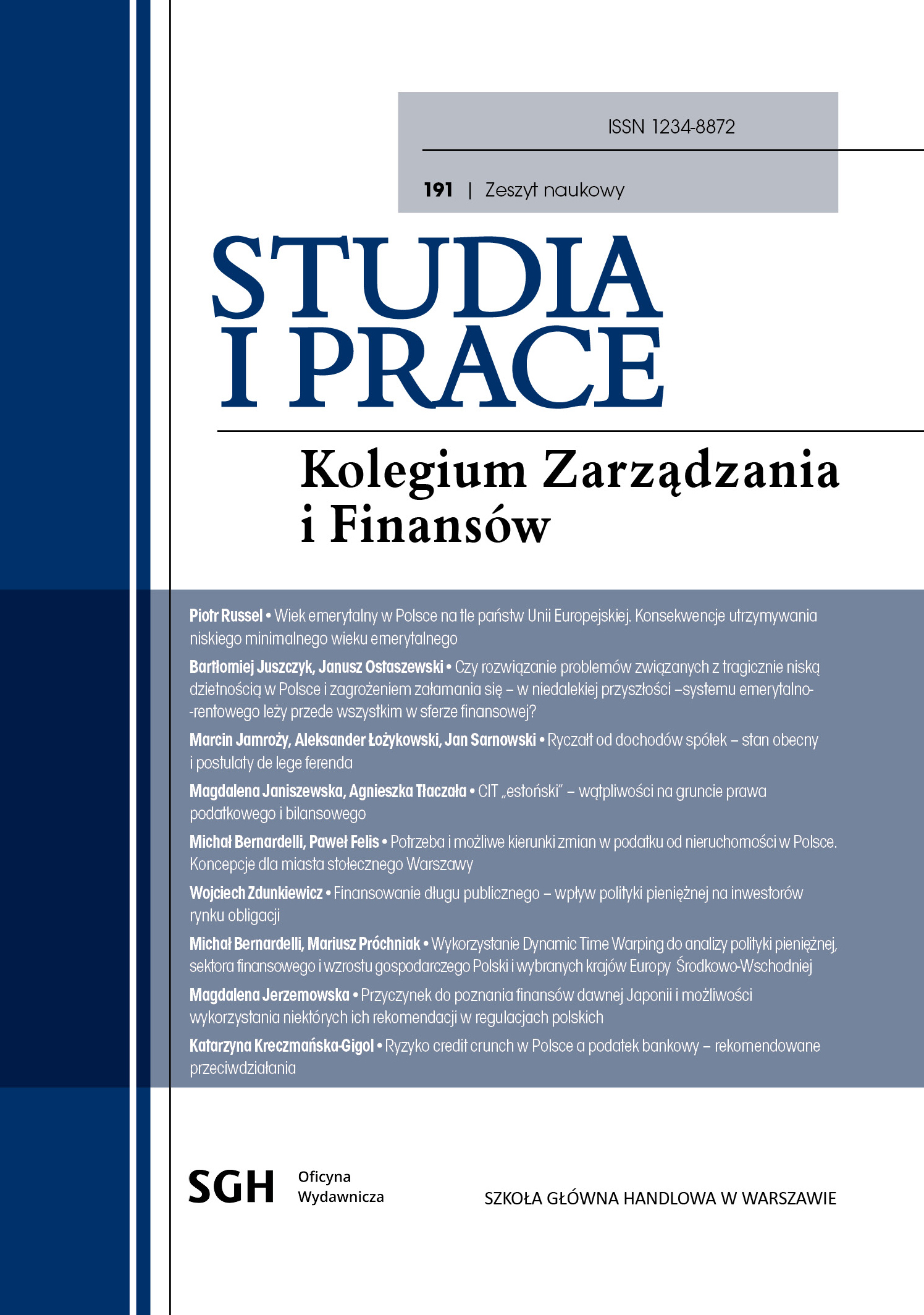Contribution to understanding the finance of ancient Japan and the possibility of implementing some of its recommendations in Polish regulations
DOI:
https://doi.org/10.33119/SIP.2023.191.8Keywords:
finance, uji, state, taxesAbstract
The aim of the article is to attempt to showcase the finances of ancient Japan during the Yamato [250–710], Nara [710–794], and early Heian [794–1185] eras and examine whether some of their principles and recommendations can be implemented in contemporary Polish finance. Ancient Japan developed a distinct and specific system of state management and financing based on rice, giving the utmost priority to maximising the interests of the aristocracy. Over the course of the analysed eight centuries, the country centralised, transforming from a federation of independent uji into the establishment and growth of the Ritsuryo State. The conducted research contributes to understanding the financial system in operation during that period and identifies factors contributing to the development and destruction of the Ritsuryo State and its finances. The literature analysis revealed that some legal recommendations from the 7th century are still relevant enough to be implemented in modern Polish finance. The research methodology involved a critical analysis of the subject literature, available mostly in English, including manuscripts and articles on the history and economy of Japan, as well as the history of Japanese law. So far Polish economic literature has paid little attention to the issues of ancient Japanese finance. This study represents one of the first attempts to fill this research gap. The article may be of interest to individuals exploring Japanese economic history, finance, and corporate governance.
Downloads
References
1. Andressen C. [2002], A Short History of Japan. From Samurai to Sony, Allen & Unvin, Australia.
2. Asakawa K. [1914], The Origin of the Feudal Land Tenure in Japan, „The American Historical Review”, vol. 20, iss. 1, https://doi.org/10.1086/ahr/20.1.1
3. Brinley F., Kikuchi D. [1912], A History of the Japanese People from the Earliest Times to the End of the Meiji Era, The Encyclopaedia Britannica Co, New York – London.
4. Farris W.W. [2009], Japan to 1600, University of Hawai’i Press, https://www.perlego.com/ book/1319198/japan-to-1600¬a-social-and-economic-history-pdf
5. Hane M., Perez G. [2018], Premodern Japan. A Historical Survey, Routledge Taylor & Francis Group, New York – London.
6. Hara K. [1920], An Introduction to the History of Japan, Yamato Society Publication, G.P. Putnam’s & Sons, The Knickerbocker Press, New York–London.
7. Henshall K.G. [2012], A History of Japan: From Stone Age to Superpower, Palgrave Macmillan, Basingstoke, New York.
8. Mason R.H.P., Caiger J.G. (John Godwin) [1997], A History of Japan / R.H.P. Mason and J.G. Caiger, C.E. Tuttle Co. Rutland, Vt. Tokyo, Rutland, Vermont, Singapore.
9. Meyer M.W. [2009], Japan. A Concise History, Rowman & Littlefield Publishers, Plymouth.
10. Morton W.S., Olenik J.K. [2005], Japan. Its history and Culture, McGraw-Hill Companies, New York. 11. Murdoch J. [1910], History of Japan. From the Origins to The Arrival of the Portuguese in 1542 A.D., vol. I, The Asiatic Society of Japan, London.
12. Sansom G.B. [1963], A History of Japan to 1334, vol. 1, Stanford University Press, California.
13. The Cambridge History of Japan [2008a], vol. 1, red. D.M. Brown, Cambridge University Press, Cambridge, doi:10.1017/CHOL9780521223522
14. The Cambridge History of Japan [2008b], vol. 2, red. D. Shively, W. McCullough, Cambridge University Press, Cambridge, doi:10.1017/CHOL9780521223539
15. Totman C.D. [2005]. A History of Japan, Blackwell Publishing Ltd, Oxford, Carlton.
Artykuły prasowe
1. Batten B.L. [1986], Foreign Threat and Domestic Reform: The Emergence of the Ritsuryō State, „Monumenta Nipponica”, vol. 41, no. 2, JSTOR, www.jstor.org/stable/2384665.
2. Batten B.L. [1993], Provincial Administration in Early Japan: From Ritsuryō Kokka to Ōchō Kokka, „Harvard Journal of Asiatic Studies”, vol. 53, no. 1, JSTOR, https://doi.org/10.2307/2719469.
3. Carkeek V.M. [1926], The Taihō Code, the First Code of Japan, „Washington Law Review”, vol. 1, no. 3.
4. Frohlich J. [2003], Land Administration in Medieval Japan: Ito no shô in Chikuzen Province, „History”, vol. 88, no. 1(289).
5. Hérail F. [2014], The Position and Role of Provincial Governors at the Height of the Heian Period, „French Journal of Japanese Studies”, 3, https://journals.openedition.org/cjs/658
6. Kiley C.J. [1973], State and Dynasty in Archaic Yamato, „The Journal of Asian Studies”, vol. 33, no. 1, https://www.jstor.org/stable/2052884
7. Kito K. [1986], Brief History of Development of Ancient and Medieval Land Systems in Japan, „Dialogues D’histoire Ancienne Année”, 12, https://www.persee.fr/doc/dha_0755-7256_1986_ num_12_1_1735
8. Klityńska P. [2016], Myśl Konfucjusza, „Acta Erasmiana”, XIII, 13, http://repozytorium.uni. wroc.pl/Content/78929/06_Klitynska_P_Mysl_Konfucjusza.pdf
9. Nagahara K. [1975], Landownership under the Shōen-Kokugaryō System, „Journal of Japanese Studies”, vol. 1, no. 2, JSTOR, www.jstor.org/stable/132127 140 Magdalena Jerzemowska
10. Nagata M.L. [2008], Brotherhoods and Stock Societies: Guilds in Pre-Modern Japan, „International Review of Social History”, vol. 53, www.jstor.org/stable/26405470, dostęp: 3.08.2021.
11. Reischauer R.K. [1937], The Japanese Shōen (莊 園), or Manor: Some Useful Terminology, „Journal of the American Oriental Society”, vol. 57, no. 1, https://doi.org/10.2307/594783.
12. Sato E. [1979], Ōyama Estate and Insei Land Policies, „Monumenta Nipponica”, vol. 34, no. 1, https://doi.org/10.2307/2384282.
13. Szklarczyk P. [2018], Recepcja prawa chińskiego i myśli konfucjańskiej w Japonii w okresie między VI a IX wiekiem po Chrystusie, „Wrocławskie Studia Erazmiańskie”, „Studia Erasmiana Wratislaviensia”, 12.
14. Yamamura K. [1974], The Decline of the Ritsuryō System: Hypotheses on Economic and Institutional Change, „The Journal of Japanese Studies”, vol. 1, no. 1, https://doi.org/10.2307/133435
15. Yamamura K., Murakami Y. [1984], Ie Society as a Pattern of Civilization: Introduction, „Journal of Japanese Studies”, vol. 10, no. 2, http://www.jstor.org/stable/132142









